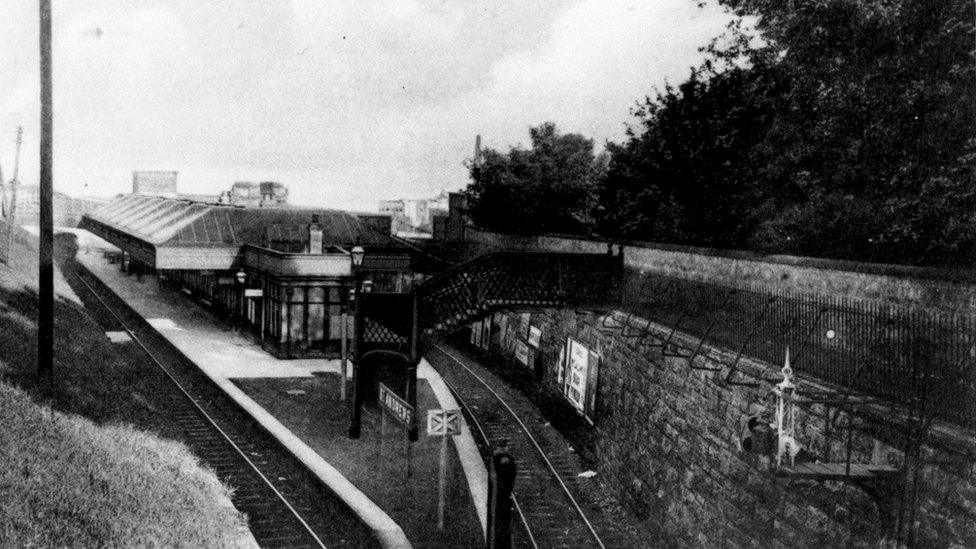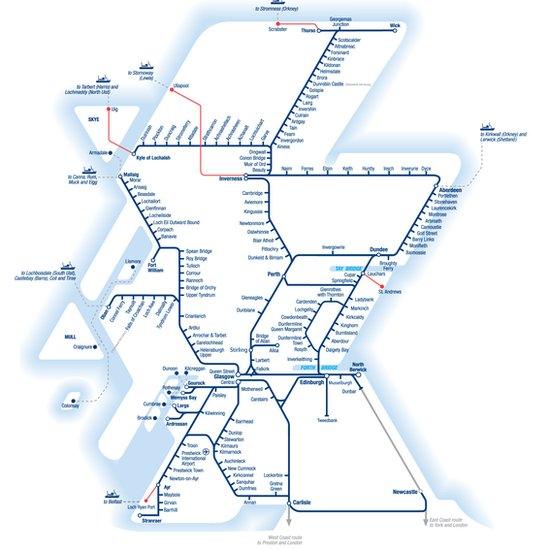Battling against Beeching
- Published

St Andrews has been without a railway since the town's station closed in 1969
"Wear the opposition down, that's the secret".
Those are the words of the veteran rail campaigner, Madge Elliot.
We met in July, on board a train speeding northwards through the sunlit Borders countryside.
Madge is just one of a small army of campaigners who have fought long and hard for the route from the Borders to Edinburgh Waverley to be reopened.
Almost half a century after the Waverley line was axed in the Beeching cuts and Madge marched on Downing Street, members of the Campaign for Borders Rail really do have something to celebrate.
The author and rail expert, David Spaven, says they have achieved "one of the most remarkable reversals of fortune in British railway history".
In his book, Waverley Route - The Battle for the Borders Railway, Mr Spaven points out the new line is the longest to be built in Scotland since 1901.
He says it's also the longest new domestic railway to be opened anywhere in Britain for more than a century.

The success of the Borders Railway campaign has inspired others around the country
Nick Bethune, UK Parliamentary Officer at the Campaign for Borders Rail, agrees.
He said: "The Borders Railway should be recognised as one of the greatest achievements of grassroots rail campaigning in British history.
"Other route re-openings in recent years in Scotland - Larkhall, Alloa, Airdrie to Bathgate - have essentially been top down schemes conceived by local and central government.
"But the origins of the railway to Galashiels and Tweedbank can be traced back to the vision of Borders-based Simon Longland in the early 1990s.
"This led to the founding of the CBR in 1998, under the inspired leadership of our first chair, Petra Biberbach.
"The campaign played a big part in persuading Borderers that they really could get their railway back."
Now, with a royal opening just days away, the Campaign for Borders Rail is also inspiring campaigners elsewhere in Scotland.
St Andrews may have an ancient university and a world-famous golf course, but it has no rail link.
In a car park in the centre of the town, I meet Jane Ann Liston of the Starlink campaign group.

Recent years have also seen the return of the Larkhall, Alloa and Airdrie to Bathgate lines
She explains how this was the site of St Andrews' railway station and, using archive photographs, points out where the platforms once stood.
The line to St Andrews was closed on 6 January 1969, the same day as the Waverley Route, forcing local people to end their rail journeys at Leuchars.
Ms Liston tells me: "I think the success with the Borders line is demonstrating what is possible.
"It's more than thirty miles long and it's being reopened.
"All that's required to reconnect St Andrews to the rail network is just under five miles of track.
"One would have thought if you can put back thirty miles of track, then maybe you can build five."
But experts tell me it is another rail line, elsewhere in Fife, which is the strongest candidate for the next reopening.
The Levenmouth Rail Campaign was set up to secure the reopening of the line between Thornton and Leven in East Fife.
It "enthusiastically welcomes" the launch of the Borders rail link, and sees it as giving hope for the future.
The campaign's chairman, Eugene Clarke, told me: "It is heartening to see yet another Scottish rail line being put back into operation - even though it's taken almost 50 years.
"The line here, roughly five miles long, has the great advantage of still being in place and, in fact, the first mile remains in use.
"The cost of the project has been estimated at around £60m, a fraction of the cost of the Borders line."
Intensive scrutiny
The total cost of the line between Edinburgh Waverley and Tweedbank is said to be £350m.
Success in the Borders has clearly created a new found sense of optimism amongst campaigners elsewhere.
But at a time of severe constraints on public expenditure, all transport projects reliant on taxpayers' cash face intense scrutiny.
That could lead to a situation with a certain sense of irony arising in the years ahead.
With limited funding available, campaigners elsewhere may find themselves in competition with the backers of an extension to the Borders line.
If the route south of Edinburgh and Midlothian proves popular with commuters and tourists, demands for a rail service from the townsfolk of Hawick will undoubtedly grow louder.
But for now, it's time for celebration amongst the dedicated band of rail campaigners in communities across Scotland.
What would the late Dr Richard Beeching, the mastermind of many of the cuts, make of it all?
Few will be worrying about that this weekend, as the champagne corks pop deep in the Borders countryside.